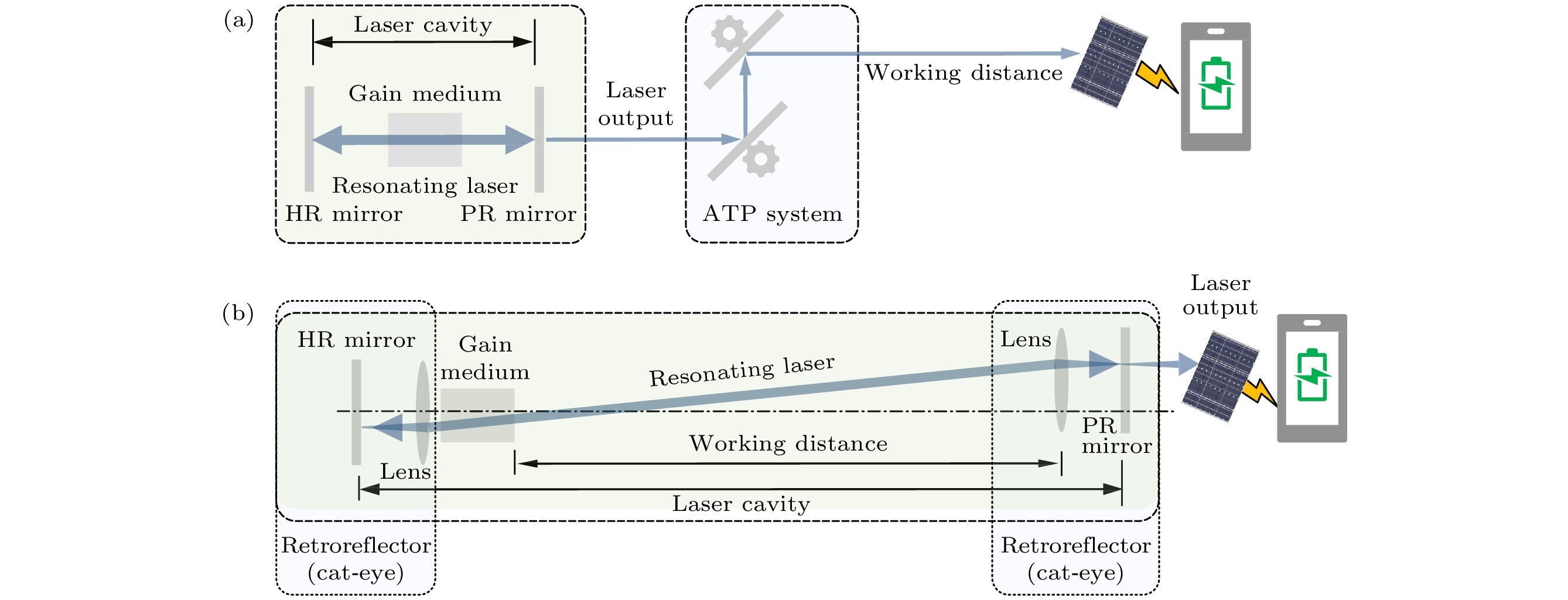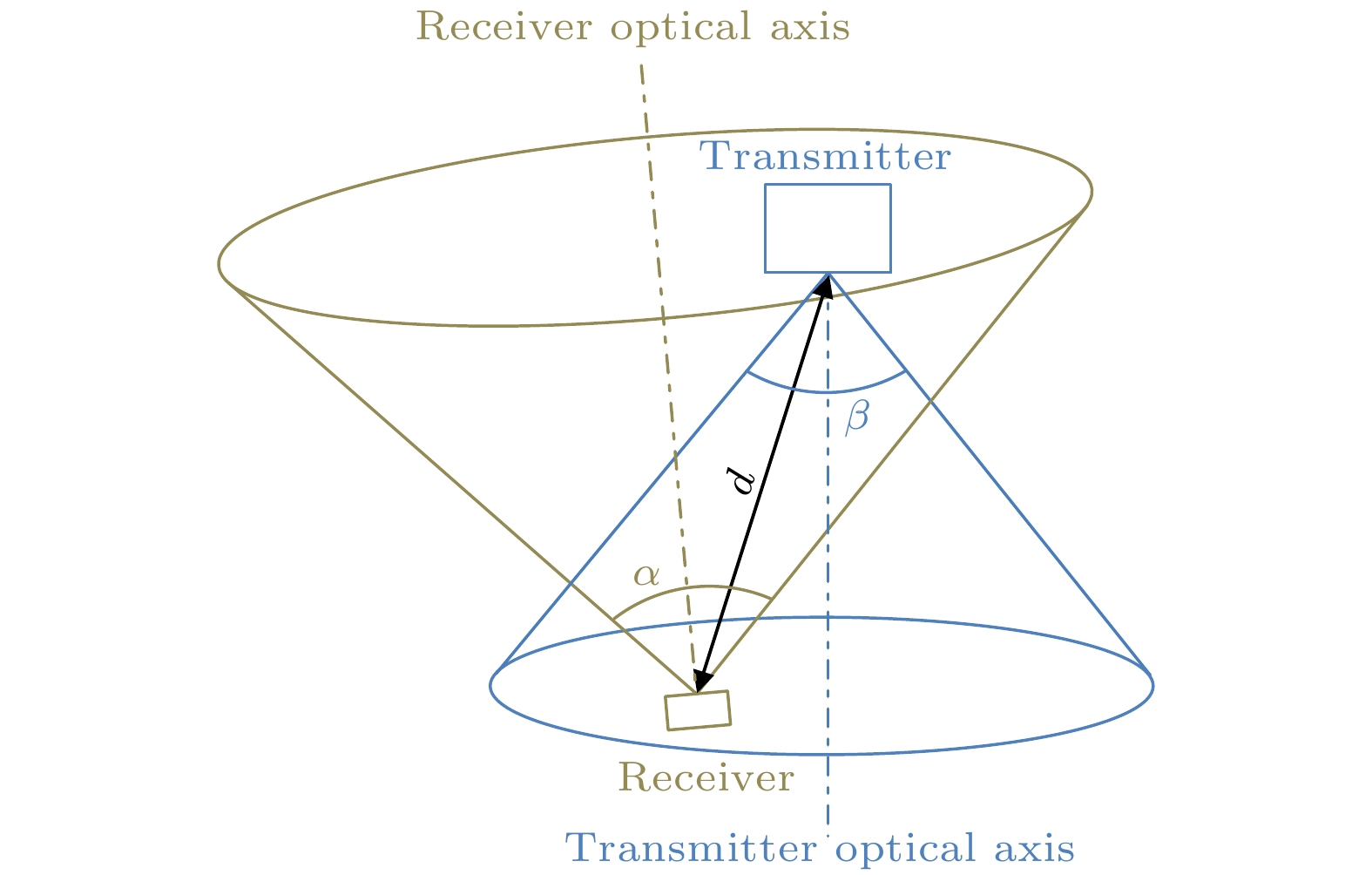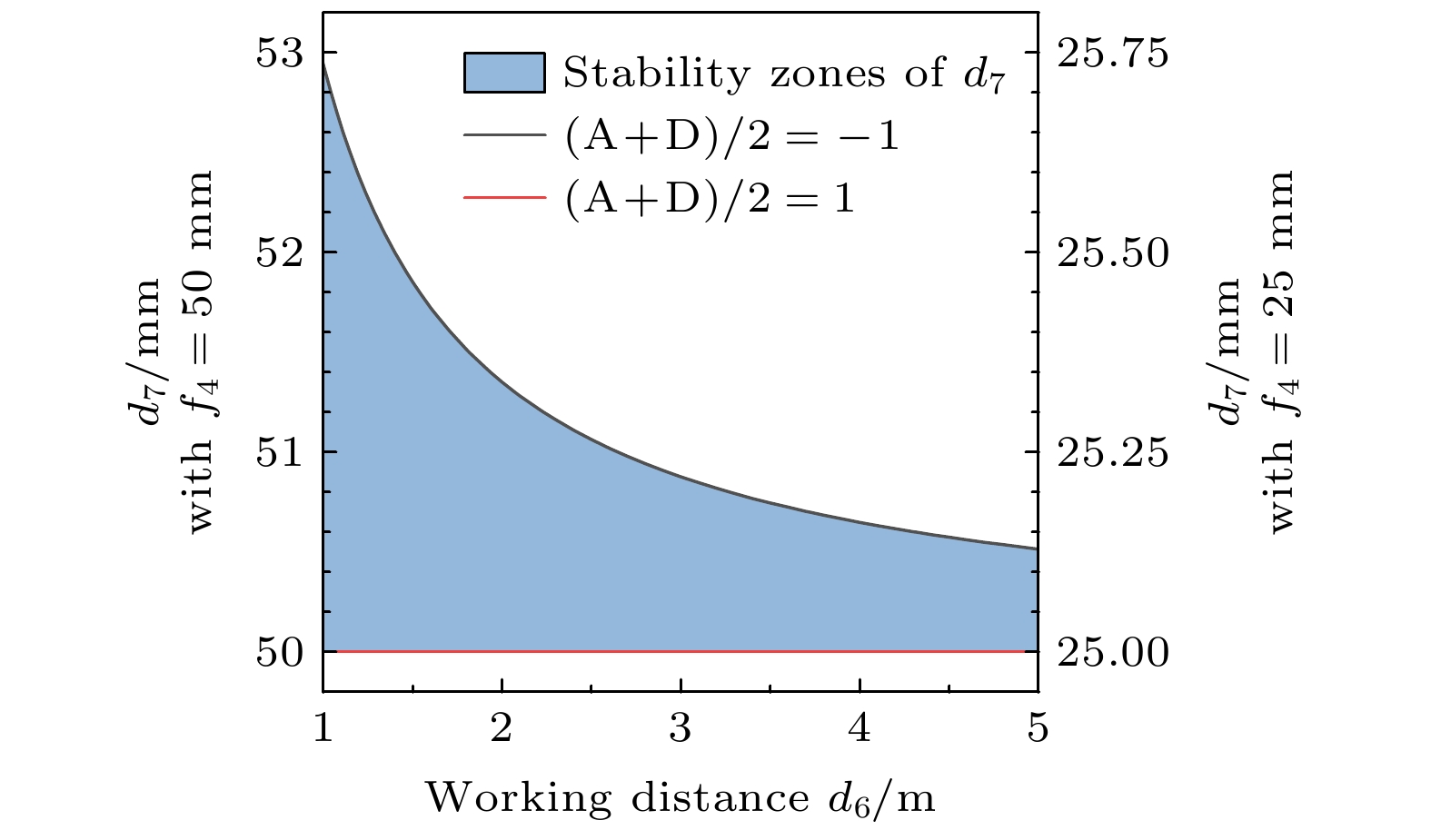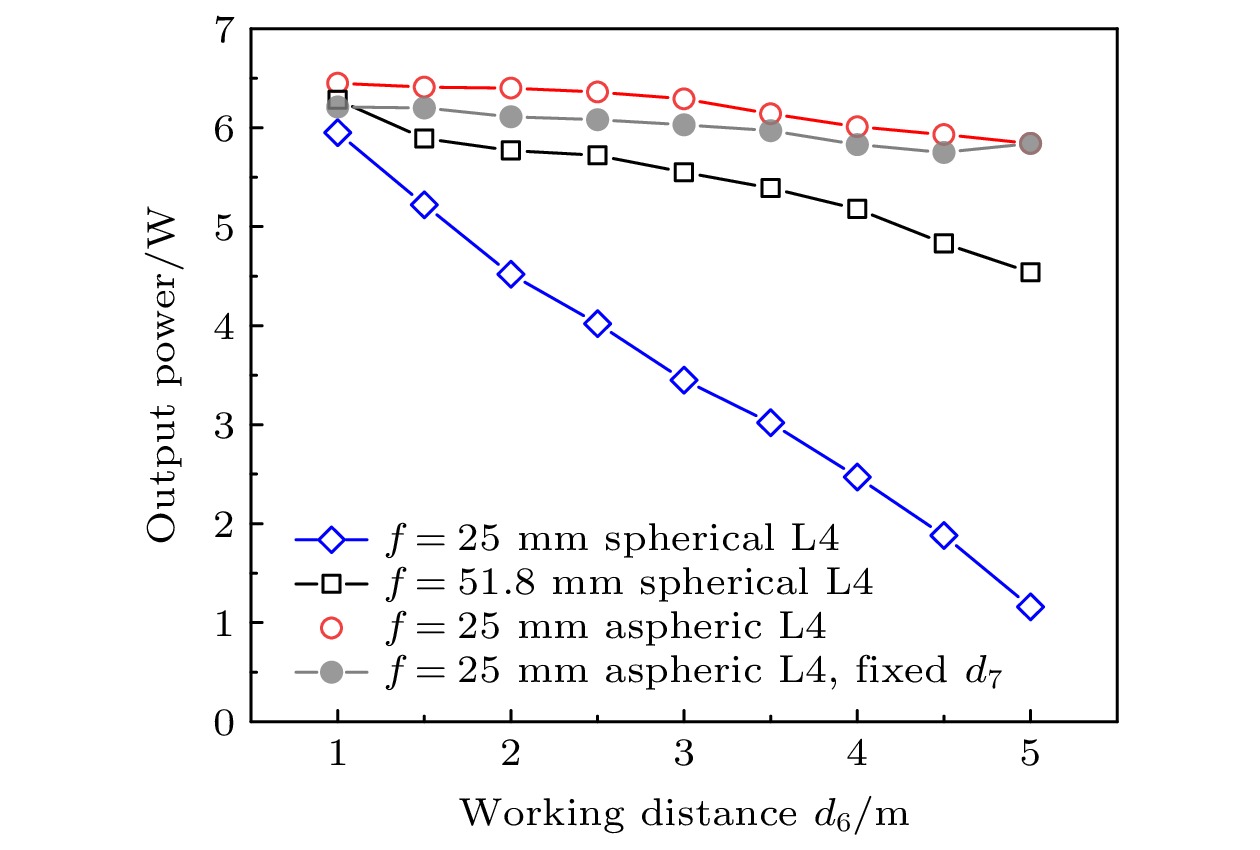-
利用具有逆反射特性的光学元件构成激光器的谐振腔, 能够赋予激光器大范围免调试工作的潜力. 本文讨论了谐振激光自适应无线传能/通信等新兴应用对激光器免调试工作范围的要求, 设计了基于猫眼逆反射器的大范围免调试激光器, 采用腔内望远镜系统和复合腔结构分别拓展激光器的工作距离范围和提升激光安全性. 通过对激光谐振腔的稳定性分析和对猫眼逆反射器的像差分析, 明确了球差和场曲导致的猫眼离焦分别是限制免调试激光器工作距离和视场的关键因素. 实验中通过优化光学设计补偿像差, 实现了端面泵浦Nd:GdVO4激光器的大范围免调试运转. 16.6 W泵浦功率下, 激光器接收端在1—5 m工作距离范围内移动和在±30°接收端视场范围内转动时输出功率保持在5 W以上, 功率波动小于10%, 无需重新准直调节. 5 m工作距离下, 在4.6°发射端视场内输出功率保持在其最大值的50%以上, 对应接收端横向移动范围达到40 cm. 本工作明确了猫眼腔免调试激光器的设计优化原则, 为相关研究提供了实验结果参考.Lasers with cavities consisting of retroreflecting elements can give the potential for large-dynamic-range alignment-free operation, which makes the important applications in adaptive wireless laser power transfer/communication possible. In such an emerging approach based on resonant laser beam in the cavity, the laser is delivered to the photovoltaic cell for charging application (or photodiode for communication application) at the receiver automatically, without the necessity of positioning and aiming the receiver in conventional laser wireless power transfer techniques. The laser capable of operating alignment-free efficiently across large-dynamic-range is essential for the application. In this work, the requirements for the dynamic range of alignment-free operation are summarized. An alignment-free laser with a cavity consisting of cat-eye retroreflectors is designed, and a large alignment-free dynamic range as never before is experimentally demonstrated. Telescope system in the laser cavity is adopted to suppress the beam expansion to enhance the working distance between the laser transmitter and the receiver. Coupled cavity scheme is used to reduce the laser intensity between the transmitter and the receiver for laser safety. By calculating the stability zone of the laser cavity, it is found that the stability zone of the receiver cat-eye distance is quite narrow. Hence, the laser operation is very sensitive to the defocusing of the cat eye defocusing. Moreover, the cat eye defocusing induced by optical aberrations of spherical aberration and field curvature can be rather serious, when the long working distance results in a large beam size and the angle of incidence is large, hence limiting the effective working distance and the field of view of the alignment-free laser significantly. In the experiment, the improved optical designs with the aberrations compensation are adopted for large-dynamic-range alignment-free operation. The end-pumped Nd:GdVO4 laser at 1063 nm can deliver over 5-W output within a working distance range of 1–5 m, and a receiver field of view of ±30°, without cavity realignment. The transmitter field of view reaching 4.6° (full width at half maximum) at a working distance of 5 m is also realized, with a corresponding receiver transverse movement range of 40 cm. Our work clarifies the optimizing criteria of the large-dynamic-range alignment-free laser based on cat-eye retroreflectors.
-
Keywords:
- alignment-free laser /
- cat-eye retroreflector /
- cavity stability zone /
- optical aberration
[1] Jin K, Zhou W Y 2019 IEEE Trans. Power Electron. 34 3842
 Google Scholar
Google Scholar
[2] Liu Q W, Wu J, Xia P F, Zhao S J, Yang Y P, Chen W, Hanzo L 2016 IEEE Veh. Technol. Mag. 11 36
 Google Scholar
Google Scholar
[3] Alpert O, Paschotta R 2016 US Patent 9312660 B2
[4] Alpert O, Ronen E, Nahmias O, Mor O R, Golan L, Sagi R 2019 US Patent 10193297 B2
[5] Liu Q W, Xiong M L, Liu M Q, Jiang Q W, Fang W, Bai Y F 2022 IEEE Internet Things J. 9 13876
 Google Scholar
Google Scholar
[6] Lim J Y, Khwaja T S, Ha J Y 2019 Opt. Express 27 A924
 Google Scholar
Google Scholar
[7] Wang W, Gao Y X, Sun D, Du X, Guo J, Liang X Y 2021 Chin. Opt. Lett. 19 111403
 Google Scholar
Google Scholar
[8] Zhang Z, Zhang J W, Zhou Y L, Zhang X, Li Z W, Zhang J Y, Zhang J, Gong Y X, Liu T J, Mu J F, Ning Y Q, Qin L, Wang L J 2022 Opt. Express 30 22364
 Google Scholar
Google Scholar
[9] Javed N, Nguyen N L, Naqvi S F A, Ha J Y 2022 Opt. Express 30 33767
 Google Scholar
Google Scholar
[10] Huang J J, Li X, Zhang J P 2021 9th International Conference on Intelligent Computing and Wireless Optical Communications, Chongqing, China, June 4–7, 2021 p1
[11] Sheng Q, Wang M, Ma H C, Qi Y, Liu J J, Xu D G, Shi W, Yao J Q 2021 Opt. Express 29 34269
 Google Scholar
Google Scholar
[12] Sheng Q, Wang A H, Wang M, Ma H C, Qi Y, Liu J J, Wang S J, Xu D G, Shi W, Yao J Q 2022 Opt. Laser Technol. 151 108011
 Google Scholar
Google Scholar
[13] Innocenzi M E, Yura H T, Fincher C L, Fields R A 1990 Appl. Phys. Lett. 56 1831
 Google Scholar
Google Scholar
[14] Sheng Q, Wang A H, Ma Y Y, Wang S J, Wang M, Shi Z, Liu J J, Fu S J, Shi W, Yao J Q, Omatsu T 2022 Photoni X 3 4
 Google Scholar
Google Scholar
[15] 刘俊杰, 盛泉, 王盟, 张钧翔, 耿兴宁, 石争, 王爱华, 史伟, 姚建铨 2022 71 014204
 Google Scholar
Google Scholar
Liu J J, Sheng Q, Wang M, Zhang J X, Geng X N, Shi Z, Wang A H, Shi W, Yao J Q 2022 Acta Phys. Sin. 71 014204
 Google Scholar
Google Scholar
[16] Wang M, Ma Y Y, Sheng Q, He X, Liu J J, Shi W, Yao J Q, Omatsu T 2021 Opt. Express 29 27783
 Google Scholar
Google Scholar
[17] Sheng Q, Wang A H, Qi Y, Wang M, Shi Z, Geng J N, Liu J J, Wang S J, Fu S J, Shi W, Yao, J Q 2022 Results Phys. 37 105558
 Google Scholar
Google Scholar
[18] 刘俊杰, 齐岳, 盛泉, 王思佳, 王盟, 徐德刚, 史伟, 姚建铨 2022 红外与激光工程 51 20211108
 Google Scholar
Google Scholar
Liu J J, Qi Y, Sheng Q, Wang S J, Wang M, Xu D G, Shi W, Yao J Q 2022 Infrared Laser Eng. 51 20211108
 Google Scholar
Google Scholar
[19] Liu J J, Wang A H, Sheng Q, Qi Y, Wang S J, Wang M, Xu D G, Fu S J, Shi W, Yao J Q 2022 Chin. Opt. Lett. 20 031407
 Google Scholar
Google Scholar
[20] Lumb M P, Meitl M, Wilson J, Bonafede S, Burroughs S, Forbes D V, Bailey C G, Hoven N M, Hoheisel R, Yakes M K, Polly S J, Hubbard S M, Walters R J 2014 IEEE 40th Photovoltaic Specialist Conference, Denve, USA, June 8–13, 2014 p0491
-
图 3 免调试激光器光路示意图 (a)接收端位于发射端光轴上且朝向发射端; (b)接收端相对发射端光轴存在偏离, 且朝向与振荡光路存在夹角
Fig. 3. Schematic of the alignment-free laser: (a) The receiver and the transmitter are on the optical axes of each other; (b) the receiving end deviates from the optical axis of the transmitting end, and the orientation has an angle with the oscillating optical path.
表 1 计算和实验中所用参数
Table 1. Parameters used in the experiment and calculation.
Lenses Focal length/mm Distances Length/mm L0 10 d1 23.8 L1 24.6 d2 23 L2 24.6 d3 23.8 L3 48.3 d4 23 L4 25, 50 (51.8) d5 49.1 ft 500 d6 1000—5000 表 2 面向谐振激光自适应无线传能/通信应用的免调试激光器典型实验结果
Table 2. Typical experimental results of alignment-free lasers for adaptive resonant beam charging/communication applications
Year Retro-
reflectorLaser gain
mediumOutput power/W Optical efficiency/% Working distance/m Receiver FoV/(°) Transmitter FoV/(°) 2019[6] Corner cube SOA 0.0017 — 1 — 6.6°
(only one dimension)2021[7] CER Nd:YVO4 disk >10 — 0.15 ±13°
@ 0.15 m±8.3°@0.15 m
(0 output)2022[8] Ball lens EDFA 0.4 — 30 Unlimited — 2022[5] CER Nd:YVO4 disk >10 ~15 <3 — ±5.1°@2 m
(0 output)2022[9] CER Optically pumped VECSEL 0.863 0.57 2 — 1.37°@0.5 m
0.47°@2 m2021[10] CER — 0.012 — 2 — — Our work CER Bulk Nd:GdVO4 >5 >30 >5 ±30°@5 m 4.6°@5 m
(half maximum) -
[1] Jin K, Zhou W Y 2019 IEEE Trans. Power Electron. 34 3842
 Google Scholar
Google Scholar
[2] Liu Q W, Wu J, Xia P F, Zhao S J, Yang Y P, Chen W, Hanzo L 2016 IEEE Veh. Technol. Mag. 11 36
 Google Scholar
Google Scholar
[3] Alpert O, Paschotta R 2016 US Patent 9312660 B2
[4] Alpert O, Ronen E, Nahmias O, Mor O R, Golan L, Sagi R 2019 US Patent 10193297 B2
[5] Liu Q W, Xiong M L, Liu M Q, Jiang Q W, Fang W, Bai Y F 2022 IEEE Internet Things J. 9 13876
 Google Scholar
Google Scholar
[6] Lim J Y, Khwaja T S, Ha J Y 2019 Opt. Express 27 A924
 Google Scholar
Google Scholar
[7] Wang W, Gao Y X, Sun D, Du X, Guo J, Liang X Y 2021 Chin. Opt. Lett. 19 111403
 Google Scholar
Google Scholar
[8] Zhang Z, Zhang J W, Zhou Y L, Zhang X, Li Z W, Zhang J Y, Zhang J, Gong Y X, Liu T J, Mu J F, Ning Y Q, Qin L, Wang L J 2022 Opt. Express 30 22364
 Google Scholar
Google Scholar
[9] Javed N, Nguyen N L, Naqvi S F A, Ha J Y 2022 Opt. Express 30 33767
 Google Scholar
Google Scholar
[10] Huang J J, Li X, Zhang J P 2021 9th International Conference on Intelligent Computing and Wireless Optical Communications, Chongqing, China, June 4–7, 2021 p1
[11] Sheng Q, Wang M, Ma H C, Qi Y, Liu J J, Xu D G, Shi W, Yao J Q 2021 Opt. Express 29 34269
 Google Scholar
Google Scholar
[12] Sheng Q, Wang A H, Wang M, Ma H C, Qi Y, Liu J J, Wang S J, Xu D G, Shi W, Yao J Q 2022 Opt. Laser Technol. 151 108011
 Google Scholar
Google Scholar
[13] Innocenzi M E, Yura H T, Fincher C L, Fields R A 1990 Appl. Phys. Lett. 56 1831
 Google Scholar
Google Scholar
[14] Sheng Q, Wang A H, Ma Y Y, Wang S J, Wang M, Shi Z, Liu J J, Fu S J, Shi W, Yao J Q, Omatsu T 2022 Photoni X 3 4
 Google Scholar
Google Scholar
[15] 刘俊杰, 盛泉, 王盟, 张钧翔, 耿兴宁, 石争, 王爱华, 史伟, 姚建铨 2022 71 014204
 Google Scholar
Google Scholar
Liu J J, Sheng Q, Wang M, Zhang J X, Geng X N, Shi Z, Wang A H, Shi W, Yao J Q 2022 Acta Phys. Sin. 71 014204
 Google Scholar
Google Scholar
[16] Wang M, Ma Y Y, Sheng Q, He X, Liu J J, Shi W, Yao J Q, Omatsu T 2021 Opt. Express 29 27783
 Google Scholar
Google Scholar
[17] Sheng Q, Wang A H, Qi Y, Wang M, Shi Z, Geng J N, Liu J J, Wang S J, Fu S J, Shi W, Yao, J Q 2022 Results Phys. 37 105558
 Google Scholar
Google Scholar
[18] 刘俊杰, 齐岳, 盛泉, 王思佳, 王盟, 徐德刚, 史伟, 姚建铨 2022 红外与激光工程 51 20211108
 Google Scholar
Google Scholar
Liu J J, Qi Y, Sheng Q, Wang S J, Wang M, Xu D G, Shi W, Yao J Q 2022 Infrared Laser Eng. 51 20211108
 Google Scholar
Google Scholar
[19] Liu J J, Wang A H, Sheng Q, Qi Y, Wang S J, Wang M, Xu D G, Fu S J, Shi W, Yao J Q 2022 Chin. Opt. Lett. 20 031407
 Google Scholar
Google Scholar
[20] Lumb M P, Meitl M, Wilson J, Bonafede S, Burroughs S, Forbes D V, Bailey C G, Hoven N M, Hoheisel R, Yakes M K, Polly S J, Hubbard S M, Walters R J 2014 IEEE 40th Photovoltaic Specialist Conference, Denve, USA, June 8–13, 2014 p0491
计量
- 文章访问数: 5770
- PDF下载量: 104
- 被引次数: 0














 下载:
下载:







